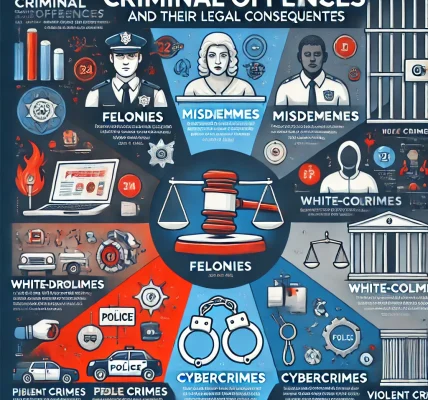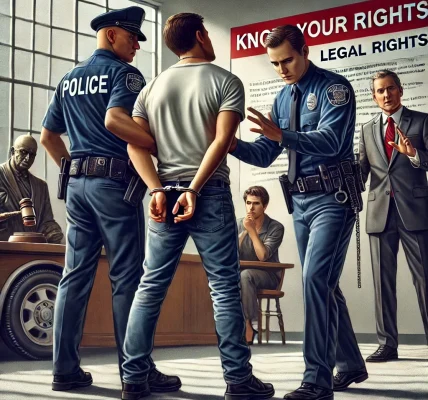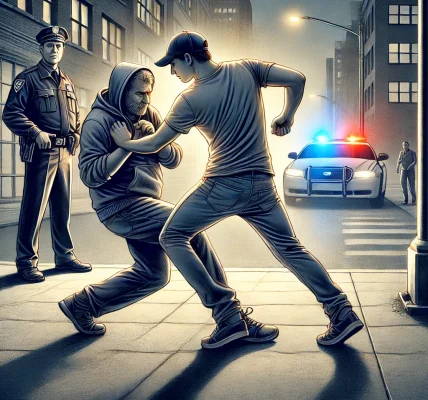Introduction
Criminal offenses are generally categorized into two main types: misdemeanors and felonies. Understanding the differences between these two classifications is crucial as they determine the severity of punishment, legal consequences, and long-term impact on an individual’s life.
This guide will explore what constitutes a misdemeanor, what qualifies as a felony, the key differences between them, and how they can affect legal proceedings and personal freedoms.
What is a Misdemeanor?
A misdemeanor is a criminal offense that is less severe than a felony. Misdemeanors typically involve minor offenses, and the penalties usually include fines, community service, probation, or jail time of less than one year. These offenses are often handled in local or municipal courts.
Common Examples of Misdemeanors:
- Petty Theft – Stealing items of low monetary value.
- Disorderly Conduct – Engaging in disruptive behavior in public.
- Simple Assault – Physically harming someone without a weapon or serious injury.
- Driving Under the Influence (DUI) – First-time offenses of drunk driving.
- Public Intoxication – Being visibly drunk in a public space.
- Trespassing – Entering private property without permission.
Punishments for Misdemeanors:
- Fines – Monetary penalties depending on the offense.
- Probation – Supervised release under certain conditions.
- Community Service – Performing unpaid work for the community.
- Short-term Jail Time – Up to one year, usually in a county jail.
- Rehabilitation Programs – Courts may order anger management or substance abuse programs.
What is a Felony?
A felony is a more serious crime that carries severe penalties, including imprisonment for more than one year, heavy fines, and potential loss of civil rights (e.g., voting, firearm ownership). Felonies are handled in higher courts and may involve state or federal prosecution.
Common Examples of Felonies:
- Murder – Intentionally causing the death of another person.
- Rape or Sexual Assault – Non-consensual sexual acts.
- Burglary – Unlawfully entering a building to commit theft or another crime.
- Drug Trafficking – Distribution or sale of illegal substances.
- Kidnapping – Unlawfully detaining or transporting a person against their will.
- Aggravated Assault – Physical harm involving serious injury or a deadly weapon.
Punishments for Felonies:
- Long-term Imprisonment – Usually served in state or federal prison.
- Heavy Fines – Amounts vary based on the crime.
- Parole or Probation – Supervised release after serving part of the sentence.
- Death Penalty – Applied in some states for severe crimes like capital murder.
- Loss of Rights – Convicted felons may lose voting rights, firearm ownership, and employment opportunities.
Key Differences Between Misdemeanors and Felonies
| Factor | Misdemeanor | Felony |
|---|---|---|
| Severity | Less serious crimes | More serious crimes |
| Punishment | Fines, probation, up to 1 year in jail | Over 1 year in prison, larger fines |
| Court Process | Local or municipal courts | Higher state or federal courts |
| Impact on Rights | Minimal long-term impact | Loss of civil rights and employment restrictions |
| Examples | Disorderly conduct, trespassing | Murder, drug trafficking |
How a Criminal Charge is Determined
The classification of an offense as a misdemeanor or felony depends on several factors:
- Severity of the Crime – How much harm was caused to the victim or society?
- Intent – Was the act intentional or accidental?
- Criminal History – Repeat offenders often face harsher classifications.
- Use of Weapons – Crimes involving firearms or deadly weapons are more likely to be felonies.
- Monetary Damage – The financial impact of the crime can determine its classification.
- State Laws – Different states have different thresholds for classifying crimes.
Consequences of a Criminal Conviction
For Misdemeanors:
- Short-term inconvenience: Jail time, fines, or probation.
- Limited criminal record impact: Many misdemeanors can be expunged.
- Minimal employment restrictions: Some employers may still conduct background checks.
For Felonies:
- Permanent criminal record: Harder to expunge or seal.
- Restricted job opportunities: Many employers are hesitant to hire felons.
- Housing limitations: Some landlords refuse to rent to felons.
- Voting and firearm restrictions: Felons may lose these rights permanently.
Can Misdemeanors Be Upgraded to Felonies?
Yes, in some cases, a misdemeanor charge can be elevated to a felony due to:
- Aggravating Circumstances – If a crime involved a deadly weapon or resulted in serious injury.
- Repeat Offenses – Multiple misdemeanor offenses may lead to felony charges.
- Violation of Probation – Breaking probation terms can result in harsher penalties.
Can Felonies Be Reduced to Misdemeanors?
Yes, under certain conditions, a felony charge can be reduced to a misdemeanor through:
- Plea Bargains – Negotiating with prosecutors for a lesser charge.
- Expungement or Record Sealing – Some states allow non-violent felonies to be downgraded after serving the sentence.
- Good Behavior – Demonstrating rehabilitation can lead to reduced charges.
What to Do If You Are Charged with a Crime
- Remain Calm – Do not resist arrest or argue with law enforcement.
- Exercise Your Right to Remain Silent – Anything you say can be used against you.
- Request an Attorney – Legal representation is crucial in criminal cases.
- Do Not Sign Anything Without Legal Advice – Prosecutors may attempt to pressure you into confessions.
- Prepare for Court – Work with your lawyer to build a defense strategy.
Conclusion
Understanding the difference between misdemeanors and felonies is essential for navigating the legal system. While misdemeanors are less severe and often have limited long-term consequences, felonies carry significant penalties, including long prison sentences and loss of civil rights. If charged with a crime, seeking legal counsel immediately is the best course of action to ensure a fair outcome.




